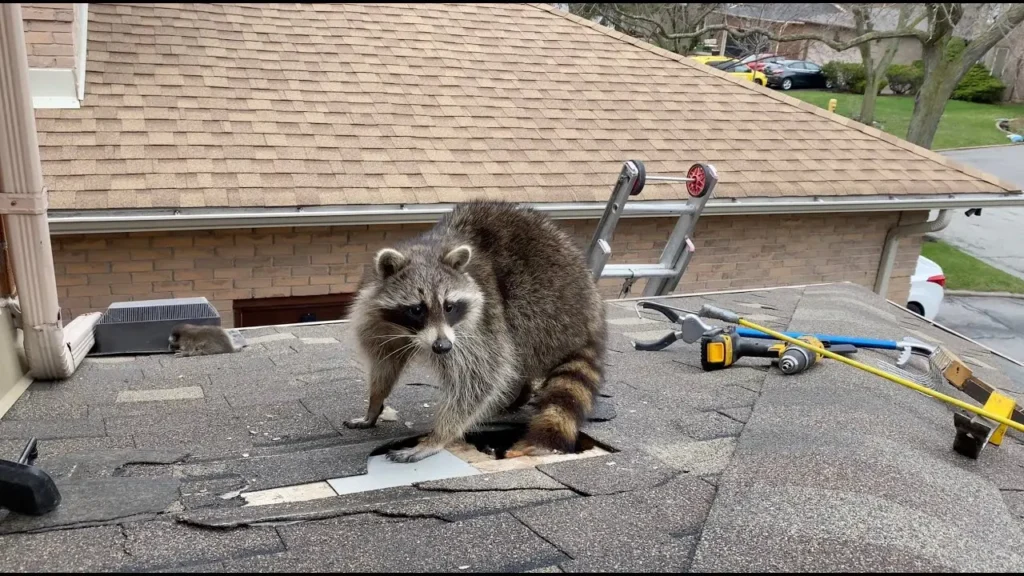Having raccoons in the roof presents a common urban challenge faced by homeowners across regions.
These resourceful creatures often seek refuge in attics and rooftops, leading to a range of potential issues.
In this discussion, we will delve into the reasons behind raccoons choosing roofs as their habitat, explore the risks associated with their presence, and offer effective strategies for prevention and removal.
Whether you’ve encountered raccoon intrusions or aim to safeguard your home from such occurrences, this exploration provides valuable insights to address the issue.
How to Remove Raccoons in the Roof

There are various methods for removing raccoons from your roof such as:
- Live Trap Method: One effective way to deal with raccoons is by using a live trap. You can place baby raccoons as “live bait” in a cage to attract and capture the mother raccoon for removal.
- Metal Flashing Installation: Prevent raccoons from gaining access to your roof by installing metal flashing around the corners of your house, making it difficult for them to climb up.
- Tree Branch Trimming: Trim tree branches that reach close to your roofline to eliminate potential access points for raccoons.
- Raccoon Eviction Fluid: Raccoon eviction fluid, which mimics a predator scent, can be used to deter mother raccoons. It signals the presence of a male raccoon, encouraging the mother to relocate her family elsewhere.
- Food Source Elimination: Remove any food sources around your property that might attract raccoons, reducing the likelihood of them considering your property a good place to stay.
- Metal Sheeting Placement: Protect your roof and trees by placing metal sheeting around them. This makes it challenging for raccoons to climb and access your property.
- Professional Wildlife Removal: When dealing with raccoon infestations, it’s often best to hire a professional wildlife removal service. They have the expertise and equipment to safely and effectively remove raccoons from your roof.
Each of these methods can be employed to address raccoon issues, but it’s important to consider the specific situation and local regulations when choosing the most appropriate approach for raccoon removal.
For more information, please consult our guide on ‘How to get rid of Raccoons.’
Risks of Having Raccoons in the Roof
Here are different ways to express the risks associated with having raccoons in your roof:
- Structural Degradation: The presence of raccoons in your roof can lead to substantial structural damage. They are capable of tearing through shingles, roof decking, fascia, and soffit, potentially compromising the integrity of your home. Additionally, if they damage wiring, it can pose a significant fire hazard.
- Health Concerns: Raccoons are carriers of various diseases and parasites that pose a threat to both humans and pets. Raccoon droppings can contain harmful roundworms, parasites, and a range of diseases. Common issues include infestations of fleas, ticks, and parasites. Moreover, raccoons can carry rabies, a serious and potentially fatal disease.
- Formation of Latrines: Raccoons can establish latrines in your attic, resulting in the accumulation of feces and urine. This can generate a strong and unpleasant odor and attract other pests, such as insects and rodents, compounding the problem.
- Threat to Pets: Raccoons can pose a direct threat to your pets. They may attack, injure, or even fatally harm pets like cats and small dogs, particularly if they feel cornered or threatened.
- Fire Hazard: Raccoons have been known to chew on electrical wires, which can create a hazardous situation by increasing the risk of electrical fires.
It is of utmost importance to promptly remove raccoons from your roof to mitigate these risks and safeguard both your property and the well-being of those residing within it.
Can Raccoons Break Through Roof
Yes, raccoons possess the ability to breach your roof’s integrity. These resilient and agile creatures can inflict substantial harm on your roof, including the tearing of shingles, roof decking, fascia, and soffit materials.
Furthermore, their tendency to chew on electrical wiring introduces the peril of a potential fire hazard. Left unattended, raccoons can establish latrine sites, leading to sizable accumulations of droppings that not only compromise shingles but also facilitate the spread of diseases.
Consequently, it is imperative to promptly expel raccoons from your roof to preempt any damage or health-related concerns.
How to Prevent Raccoons in the Roof
Some of the best tips to prevent raccoons from getting on your roof are:
- Trim Trees and Plants: Prune trees and shrubs around your home to obstruct raccoons’ easy access from nearby vegetation to your roof.
- Eliminate Food Sources: Remove any potential food sources in the vicinity of your home that might attract raccoons, discouraging them from staying in the area.
- Install Metal Sheeting: Secure your roof and the base of trees on your property with metal sheeting, creating obstacles that make it challenging for raccoons to climb.
- Install Electric Fencing: Erect electric fencing on structures that raccoons can use to reach your roof, providing a deterrent that discourages their attempts.
- Maintain Roof and Attic: Regularly clean your roof and attic to reduce clutter and eliminate enticing shelter options for raccoons.
- Use Metal Screens and Pest Guards: Shield openings in your roof, vents, or chimney with sturdy metal screens and pest guards to prevent raccoons from entering your home.
- Seek Professional Assistance: If you struggle to prevent raccoons from accessing your roof, consider enlisting the services of a professional wildlife removal team. They can assess the root of the issue and implement effective solutions.
By following these measures, you can significantly enhance your efforts to keep raccoons off your roof and protect your property.

